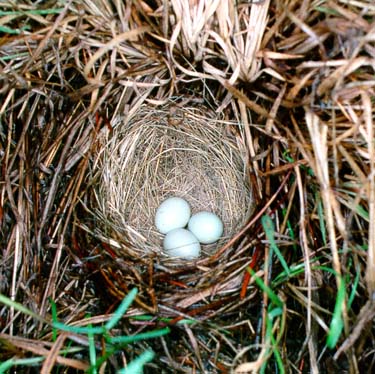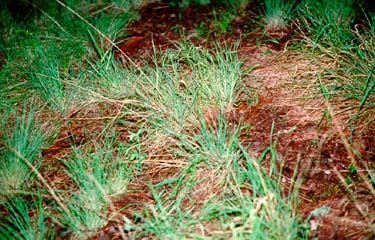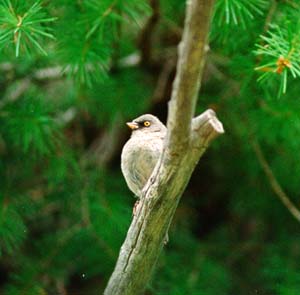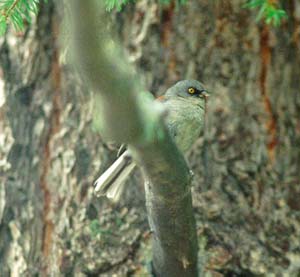Yellow-eyed Junco, Nest with Eggs Photographs and Sound Recording, Mt. Graham, Arizona
Photos by Greg Clark, July 18, 1999
 If you are used to seeing Dark-eyed Juncos, the first sighting of a Yellow-eyed Junco is quite startling. Found at very high elevations in southeastern Arizona, this bird does share some characteristics with other Juncos. The white tail feathers, and ground feeding, are very similar to the other Juncos. However, the Yellow-eyed Junco tends to run on the ground rather than hop. Like the other Juncos, this bird builds a nest on the ground and the nest is very hard to find. We have been doing a Breeding Bird Survey (BBS) on Mt Graham for a few years and we always camp in the same place. This year, for the first time, a Yellow-eyed Junco was flushed from the ground near our campsite. Even with this clue, it still took Tim awhile to find the nest site. The nest area is shown in the second photograph. One of the many theories about birds and nests includes the idea that ground nesting was the first nest location strategy. Based on the terrain shown around the nest, this would still seem to be a good way to keep a nest hidden from predators. When we think of bird's nests we usually think of trees. Imagine the environmental and behavioral changes required to selectively favor nests above ground. If some birds still nest (quite successfully) on the ground today, then other species of birds must have decided to nest in a different way, and been rewarded for their efforts. Probably predation, climate, and food availability all played a part in changing a bird's nest location and construction method. It might even be possible that some birds have returned to (become predominately) ground nesting after nesting in trees during an earlier time. After all, birds have been around a lot longer than primates. If some mammals can come out of the ocean, and then return to the ocean to eventually become more like fish than quadrapeds, how difficult would it be for birds to return to ground nesting.
If you are used to seeing Dark-eyed Juncos, the first sighting of a Yellow-eyed Junco is quite startling. Found at very high elevations in southeastern Arizona, this bird does share some characteristics with other Juncos. The white tail feathers, and ground feeding, are very similar to the other Juncos. However, the Yellow-eyed Junco tends to run on the ground rather than hop. Like the other Juncos, this bird builds a nest on the ground and the nest is very hard to find. We have been doing a Breeding Bird Survey (BBS) on Mt Graham for a few years and we always camp in the same place. This year, for the first time, a Yellow-eyed Junco was flushed from the ground near our campsite. Even with this clue, it still took Tim awhile to find the nest site. The nest area is shown in the second photograph. One of the many theories about birds and nests includes the idea that ground nesting was the first nest location strategy. Based on the terrain shown around the nest, this would still seem to be a good way to keep a nest hidden from predators. When we think of bird's nests we usually think of trees. Imagine the environmental and behavioral changes required to selectively favor nests above ground. If some birds still nest (quite successfully) on the ground today, then other species of birds must have decided to nest in a different way, and been rewarded for their efforts. Probably predation, climate, and food availability all played a part in changing a bird's nest location and construction method. It might even be possible that some birds have returned to (become predominately) ground nesting after nesting in trees during an earlier time. After all, birds have been around a lot longer than primates. If some mammals can come out of the ocean, and then return to the ocean to eventually become more like fish than quadrapeds, how difficult would it be for birds to return to ground nesting.
 The nest and surrounding area.
The nest and surrounding area.


The original Yellow-eyed Junco sound recording was produced using a Sennheiser MKH70 shotgun microphone and the audio was stored on a 48 ksps DAT using a Tascam DA-P1 digital audio recorder. The recording was down-sampled to 44.1 ksps and converted to MPEG3 to reduce the file size.
download mpeg3 recording (yej_1.mp3)
download mpeg3 decoder
mirror-pole.com home
Copyright Greg Clark, 1999
 If you are used to seeing Dark-eyed Juncos, the first sighting of a Yellow-eyed Junco is quite startling. Found at very high elevations in southeastern Arizona, this bird does share some characteristics with other Juncos. The white tail feathers, and ground feeding, are very similar to the other Juncos. However, the Yellow-eyed Junco tends to run on the ground rather than hop. Like the other Juncos, this bird builds a nest on the ground and the nest is very hard to find. We have been doing a Breeding Bird Survey (BBS) on Mt Graham for a few years and we always camp in the same place. This year, for the first time, a Yellow-eyed Junco was flushed from the ground near our campsite. Even with this clue, it still took Tim awhile to find the nest site. The nest area is shown in the second photograph. One of the many theories about birds and nests includes the idea that ground nesting was the first nest location strategy. Based on the terrain shown around the nest, this would still seem to be a good way to keep a nest hidden from predators. When we think of bird's nests we usually think of trees. Imagine the environmental and behavioral changes required to selectively favor nests above ground. If some birds still nest (quite successfully) on the ground today, then other species of birds must have decided to nest in a different way, and been rewarded for their efforts. Probably predation, climate, and food availability all played a part in changing a bird's nest location and construction method. It might even be possible that some birds have returned to (become predominately) ground nesting after nesting in trees during an earlier time. After all, birds have been around a lot longer than primates. If some mammals can come out of the ocean, and then return to the ocean to eventually become more like fish than quadrapeds, how difficult would it be for birds to return to ground nesting.
If you are used to seeing Dark-eyed Juncos, the first sighting of a Yellow-eyed Junco is quite startling. Found at very high elevations in southeastern Arizona, this bird does share some characteristics with other Juncos. The white tail feathers, and ground feeding, are very similar to the other Juncos. However, the Yellow-eyed Junco tends to run on the ground rather than hop. Like the other Juncos, this bird builds a nest on the ground and the nest is very hard to find. We have been doing a Breeding Bird Survey (BBS) on Mt Graham for a few years and we always camp in the same place. This year, for the first time, a Yellow-eyed Junco was flushed from the ground near our campsite. Even with this clue, it still took Tim awhile to find the nest site. The nest area is shown in the second photograph. One of the many theories about birds and nests includes the idea that ground nesting was the first nest location strategy. Based on the terrain shown around the nest, this would still seem to be a good way to keep a nest hidden from predators. When we think of bird's nests we usually think of trees. Imagine the environmental and behavioral changes required to selectively favor nests above ground. If some birds still nest (quite successfully) on the ground today, then other species of birds must have decided to nest in a different way, and been rewarded for their efforts. Probably predation, climate, and food availability all played a part in changing a bird's nest location and construction method. It might even be possible that some birds have returned to (become predominately) ground nesting after nesting in trees during an earlier time. After all, birds have been around a lot longer than primates. If some mammals can come out of the ocean, and then return to the ocean to eventually become more like fish than quadrapeds, how difficult would it be for birds to return to ground nesting. The nest and surrounding area.
The nest and surrounding area.
